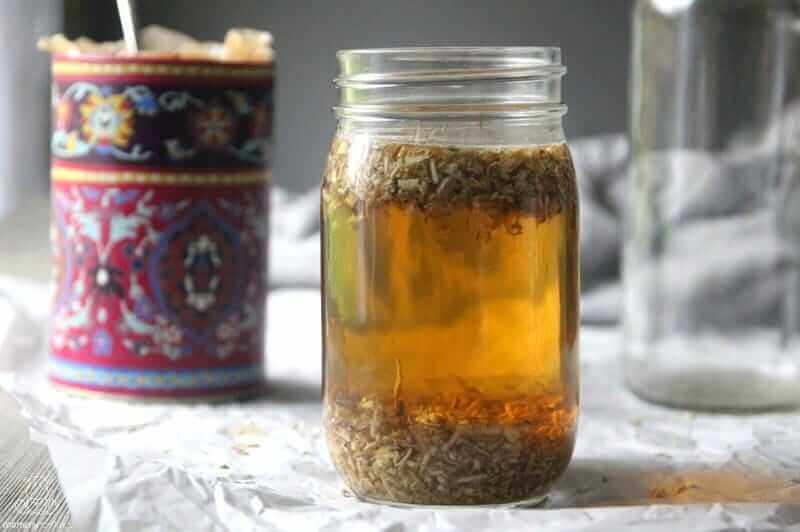
Marshmallow root is not exactly the kind of thing you buy on impulse like fair-trade chocolate. It’s the kind of herb that’s picked up for something specific, such as homemade hair detangler or a sore throat spray. Once you have it in your pantry, though, you might be wondering what else it’s good for.
The answer? A LOT.
So, what is marshmallow root?
Before they were campfire treats, marshmallows were made by boiling marshmallow root with honey to soothe sore throats and upset stomachs. That’s because marshmallow root – whose Greek name althea literally means “to heal” – contains a polysaccharide which “provides a protective, soothing coating to mucosa.” (Botanical Medicine For Women’s Health, Dr. Aviva Romm)
What can you do with marshmallow root?
This herb is available both as a powder and finely chopped root pieces. When mixed with water, it forms a mucilaginous (gel-like) consistency that soothes throat, digestive tract, and urinary tract irritation, and is also traditionally used externally as a poultice for minor burns and wounds. When taken internally, it’s usually consumed as a cold infusion or hot tea. Externally, the whole ground herb can be applied as a poultice, or just the gel can be used.
Below we’ll discuss more ways it can benefit specific situations, plus safety considerations and how to make a cold infusion, tea, and poultice.
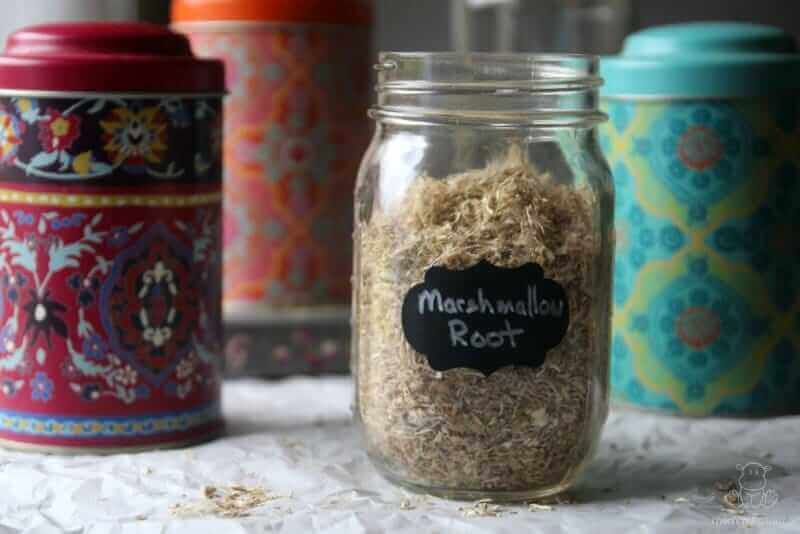
1. Heartburn (Even Pregnancy Heartburn)
According to renowned herbalist Rosemary Gladstar, “The best herbs to use for treating heartburn are those that calm the nervous system and are good digestive nervines, such as chamomile, hops and lemon balm. Mucilaginous herbs, such as marshmallow, licorice, and slippery elm, will soothe the irritated stomach lining.” (Herbal Recipe For Vibrant Health)
Although a similar herb that can help with indigestion – slippery elm – is available in pre-made lozenge form, marshmallow root is typically “prepared as an infusion, and sipped on as needed throughout the day or during an acute period of heartburn.” (Romm, 364) You’ll find instructions for making a marshmallow root infusion below.
Also, since chamomile is mentioned, I wanted to mention that Urban Moonshine has created a version of Swedish Bitters that is safe to use during pregnancy. Their Chamomile Bitters formula is helpful for easing occasional heartburn and morning sickness, and it’s free of the herbs you need to avoid during pregnancy. You can find it here.
Click here to read more about what causes heartburn, and find one of my other favorite natural remedies for heartburn here.
2. Sore Throat And Stomach Ache
Because of it’s ability to coat irritated mucous membranes, marshmallow root is often used to soothe sore throats and upset stomachs. It can be consumed as a hot tea or cold infusion – instructions for making both are listed below.
3. Improve Gut Health
Along with bone broth, gelatin and fermented foods, mucilaginous herbs such as marshmallow root are sometimes consumed as a tea or cold infusion to improve gut lining integrity. (Cole)
4. UTI Support
In this article, Dr. Aviva Romm – who is also a midwife and herbalist – recommends marshmallow root as part of a natural approach to bladder infections.
5. Marshmallow Root As A Galactogogue
As stated so eloquently by Board Certified Lactation Consultant (IBCLC) Tipper Gallagher here, it’s always important to seek to address underlying issues if breast milk supply is a concern. However, as Gallagher discuesses there are circumstances in which galactogogues can be very helpful, and marshmallow root tea (or infusion) is a good one to consider.
Mucilaginous herbs have long been used for their nutritive properties and to increase breast milk supply. Oats and barley are foods traditionally given to new mothers both as porridge and barley in stew. They are safe for daily consumption in food quantities. Marshmallow root is considered a safe herb when used as recommended. It is typically included in galactogogue infusions. There are no known contraindications to the use of marshmallow root; however, the absorption of other medications taken simultaneously might be inhibited by marshmallow root.” (Botanical Medicine For Women’s Health, Dr. Aviva Romm, 454)
6. Skincare
Marshmallow root is an emollient, or herb that heals and softens dry, inflamed skin. (Shenefelt) It is often used in skincare products.
7. Minor Burns, Wounds, And Insect Bites
According to dermatologist Dr. Kenneth Howe, “Traditionally, MRE has been used to treat skin burns and insect bites.” (Barrionuevo) That’s because when applied topically, the mucilage from marshmallow root “dries as a mild adhesive and can be used as an herbal bandage for minor wounds.” (Shenefelt)
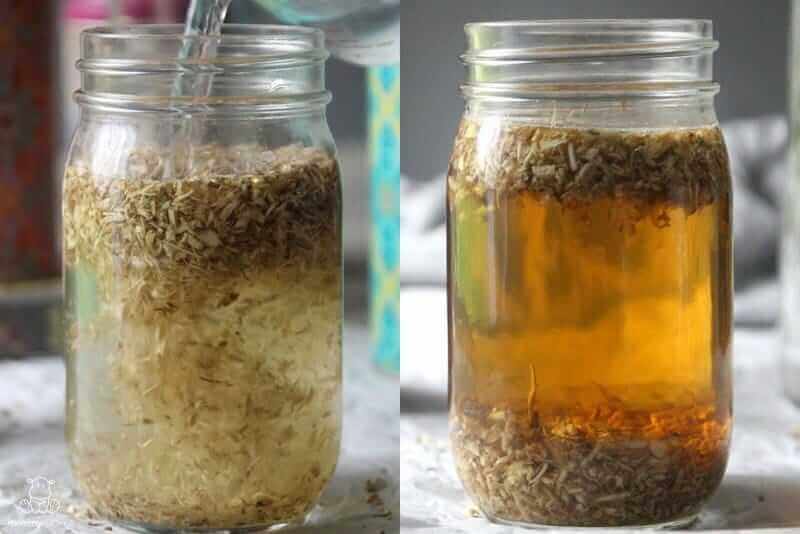
How To Make A Cold Marshmallow Root Infusion
Marshmallow root is rich in both polysaccharides and starch. When made using the cold infusion method, the healing polysaccharides are the primary component that gets extracted. A decoction (hot water extraction) extracts both.
To make a cold water infusion, fill a jar 1/4 of the way full with cut and sifted marshmallow root, then fill the rest of the jar with warm purified water and allow infusion to sit for 4-12 hours. Strain and serve.
Marshmallow Root Tea Recipe
I love this marshmallow root tea for sore throats and stomach issues, but this super simple recipe is also wonderful:
- 1.5 cups water
- 1 tablespoon cut and sifted marshmallow root
Instructions: Bring water and marshmallow to a boil, then cover and simmer on low for 20 minutes. Remove from heat, strain with a mesh strainer or cheesecloth, and sweeten if desired before serving.
How To Make A Marshmallow Root Poultice
Make a paste using powdered marshmallow root and very hot water. Apply to the area once it has cooled a little and cover with a cloth or bandage.
Is Marshmallow Root Safe During Pregnancy And Breastfeeding?
According to the Botanical Safety Handbook, 2nd edition, marshmallow is a Safety Class 1A herb – the safest rating possible. It is described as:
“Herbs that can be safely consumed when used appropriately.
- History of safe traditional use
- No case reports of significant adverse events with high probability of causality
- No significant adverse events in clinical trials
- No identified concerns for use during pregnancy or lactation
- No innately toxic constituents
- Toxicity associated with excessive use is not a basis for exclusion from this class
- Minor or self-limiting side effects are not bases for exclusion from this class”
Always check with your doctor before adding herbs to your diet, and listen to your intuition to help you make the best choice for yourself.
Marshmallow Root Contraindications
According to the Botanical Safety Handbook, 2nd edition, medications “should be taken 1 hour prior to consumption of marshmallow or several hours after consumption, as marshmallow may slow the absorption of orally administered drugs.”
What’s your favorite use for marshmallow root?
Please tell me in the comment section below!
Want more research-backed natural remedies?
No problem, I’ve created a free ebook for you – Kitchen Apothecary: 25+ Natural Remedies Using Ingredients From Your Pantry – as a gift for signing up for my newsletter. You’ll also get updates when I post about safe essential oils for pregnant/breastfeeding mamas, exclusive gifts and coupons (I was able to give away a jar of free coconut oil to anyone who wanted it recently!), plus other goodies.
Sign up using the form below.
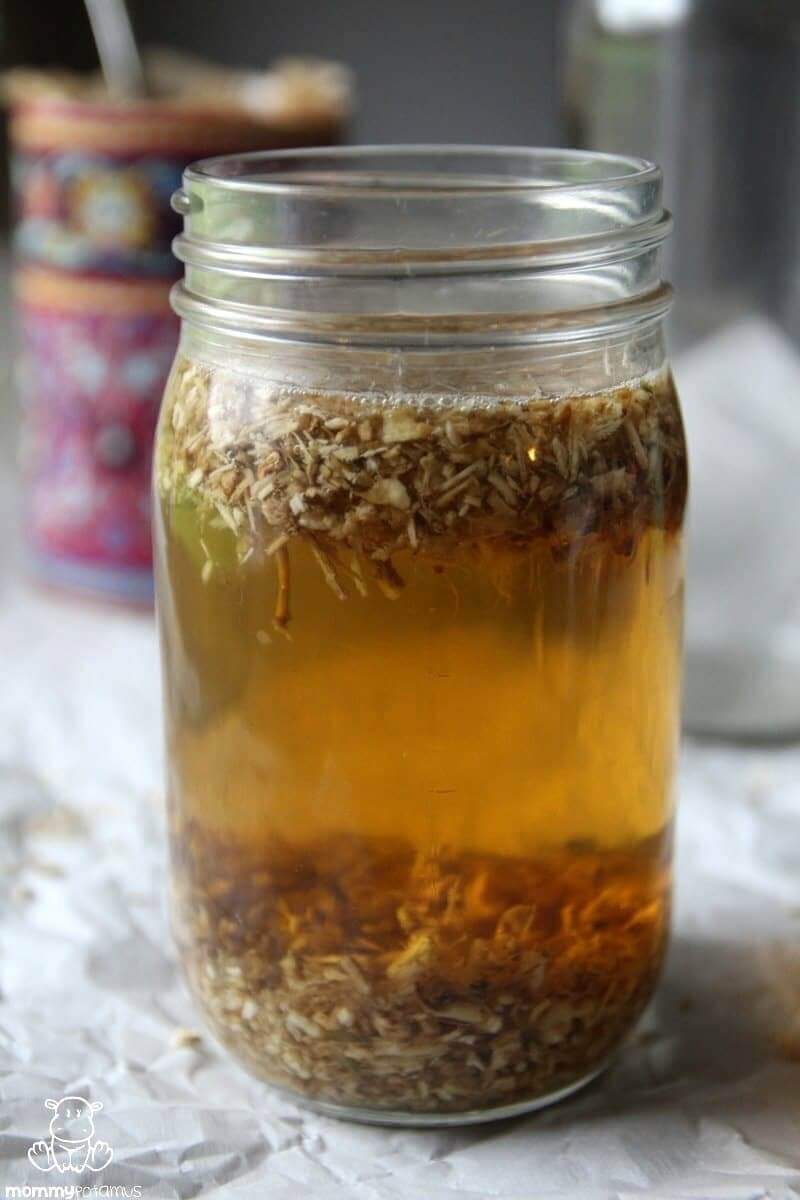



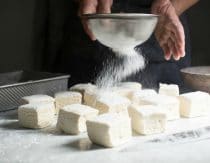

This is my first time on your webpage and I very excited to explore your recipes and get to know what you are all about. I used to make cold process soap and wanted to get back into making soap again. I was blown away by your tutorial on making warm process soap and can’t wait to gather the ingredients so I can try out your basic coconut oil soap. Thank you for sharing your knowledge and wisdom.
Hey Heather!
How do you think I could keep this on hand to have when the kiddos do have a sore thoroat? Just make the cold infusion then store in fridge as needed?
Love your Sunday emails.
Thanks!
It would be best to keep some cut/sifted root on hand and make tea as needed. It should keep for a day made up in the refrigerator, but will start to taste “flat” much beyond that ( a sign it’s time to compost your tea). If you’re not opposed to using sugar or honey you could make a syrup, which would last longer.
Do you think freezing cubes of a strong tea (to be melted in some warm or hot water when needed) would be ok?
Yes! Frozen strong tea of marshmallow root powder would work very well, if thats an easier than putting a spoonful of the dry powdered marshmallow root into a hot beverage. The tea turns into a thickened or gel consistency.
Hi, is it better to buy marshmallow root in the powder form or cut and sifted? I’m just thinking of buying whatever form will last longer and be better to use as making a cold or hot infusion. I am buying it for acid reflux and stomach problems. Thank you so much for your article!
It depends on how you’re using it. I prefer cut and sifted for tea because it’s easier to strain, but for poultices and such I prefer powdered.
Can you mix the home marshmallow root tea with another fresh brewed tea? Say chai or a chamomile? Would it be best to have the tea to aide in a healthy gut?
Yes, you can mix it with another tea.
When making the cold fusion how much of it do you drink if you up it in a 16oz of water & how many times a day is it safe to use.. I keep trying to find it but I can find any help on that part. I don’t want to over or under use it.
Good for a sore throat: a mix of licorice root, slippery elm and marshmallow root. Caution should be used with licorice because of contridications with certain medical conditions.
At one point I had a severe sore throat (due to tonsil cancer with surgery, radiation and chemo. I found an herbal tea called Throat Coat and used it with great success.
Since I was using so much of the tea, it got pretty expensive–so I concocted my own recipe for a similar tea that did the job for me.
To make a tea mix similar to the commercial one I used:
7 ½ tsp. licorice root
¾ tsp. slippery elm
½ tsp. licorice extract at 6:1 proportion
½ tsp. marshmallow root
I keep these herbs on hand and when my throat gets scratchy or irritated I bring out the tea.
I have never used the marshmallow root alone, but probably will try some tea made from it.
I enjoy the posts and the comments–always learn something new. 😀
Thank you for sharing this! I really like the throat coat tea and would enjoy making my own.
I bought marshmallow root to help with digestion. I made a cold infusion tea yesterday and it is not slimy/mucilaginous like I expected. Did I get a poor batch of root? Will it still help?
Did you use warm water when starting the infusion? Cold infusions extract polysaccharides but not much starch so the consistency is different from a heated tea. Both are beneficial.
Love this post on marshmallow root – I have a large bag and so far have only used it for tea. So, thanks!
ps…sorry but the ads on your site are over the top annoying.
I have been mixing in a tablespoon of powder with my oatmeal.
Hi there
I live in South Africa.
I have been making your coconut oil soap , tooth powder , lip balm and other products. I cannot use the commercial products anymore.
I have also been using your natural home cleaning recioes.
Thank you for sharing .
Warm Regards
Rasheeda.
So, are you saying the cold or hot extraction is better for healing? Thank you!
What’s with all the pop up ads on this site?
where could i obtain this marshmallow root, please
Amazon and Mountain Rose Herbs have Marshmallow Root.
Where can I buy marshmallow root
Dear Heather,
Ave Maria!
I have a couple of questions about mouth breathing.
1. What causes it?
2. Is there a remedy to help it?
3. Can it cause a runny nose during the day?
4. Is there a remedy for the runny nose, post nasal drip?
5. Can it all just be allergies because it is Springtime?
Hi, do you know if I can just eat the root? I made a tea from bulk chopped root and than tried the “cooked” root pieces which formed a sort of porridge-like mash. It tasted pretty good, a little nutty. But I can’t find any information on whether it’s ok to consume the whole root–everyone only makes tea from it. I found one brief reference to indigenous people eating it when other vegetables were scarce, but wasn’t sure if that was the plant or the root. Thanks
I would like to know also.
The Ancient Romans ate roasted marshmallow root as a vegetable. So it’s fine to consume.
I have a stuffy nose all the time. I think is candidia in sinuses. Any suggestions to be cured? Thanks Diana
sniffing colloidal silver or dmso works like a charm!
I like to add a teaspoon of marshmallow root powder to my coffee for my sore throat or digestion issues. It’s like a treat, yet good medicine.
Thanks
I use marshmallow root, make a powder in a coffee grinder, and and calendula to infuse coconut oil and make a body butter. As you mentioned, it is good for the skin.
Also, I make an only cold infusion for my tummy. I grind in to powder, add half a tablespoon to a pint, shake it and let it sit for a few hours and drink. I don’t strain it because I don’t mind the bits in the water. It really helps soothing the digestive lining, and the water gets a bit “thicker” or gel like. I like the taste too. I use to soothe my Crohn’s disease.
hmm this is all good to know but a friend who uses herbs to heal gave me some marshmallow root because I have sinus infections on a regular basis. I have read and searched for information supporting this and it does not seem to be described for use in sinus conditions. I was wondering if irrigation of the sinus cavity would be improve with use of warm tea of this root but that is just a guess. Any recommendations would be greatly appreciated.
I have marshmallow root capsule.
Can I open 1 or 2 capsules and make a tea with it.
thanks for the info! i tell the youth all the time “just cause you googled doesn’t mean you know more”! you sight seems to be simple and straightforward enough to be trustworthy!
Hi! Have you tried making powder from the marshmallow root? The powder is expensive and I have lots of root. Thoughts? Thanks!
Marshmallow root tea for respiratory congestion. You just can’t beat it! Love your site thank you!❤️
How is this a cold infusion? Here’s what you wrote: To make a cold water infusion, fill a jar 1/4 of the way full with cut and sifted marshmallow root, then fill the rest of the jar with warm purified water and allow infusion to sit for 4-12 hours. Strain and serve. ??
I love your blog and come turn to you regularly for information. I have a question: have you ever added marshmallow root (cold infusion) to a kombucha second fermentation?
No, I haven’t. I’m not sure if the acidity of the kombucha would break down the mucilage in the marshmallow. If you try it please let me know how it turns out!
I haven’t tried this herb out. Guess I need to check it out.
Do you think it would be possible to use it as a thickener for jellies or jams?
It doesn’t really function the same way pectin does. I don’t think it would work well in jams and jellies.
Can I freeze dry the root for future use.
I am looking for Recommendation on how to mix the marshmallow root tincture for a one-year-old. I understand it has alcohol in it and that you have to leave it sitting out for the alcohol to dissipate first. And I have been told to mix two drops with two dropperfulls of water. Can I and what would be the dosage, mix it with honey and lemon to make a cough syrup for my 1 year old granddaughter?
The recipe in this article doesn’t contain any alcohol, so I’m not sure I understand your question. Regarding usage with a 1 year old, I’m not aware of any specific guidance so I suggest consulting wih a healthcare provider.